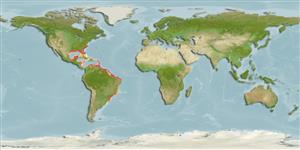Echinoidea |
Echinolampadacea |
Mellitidae
Environment: milieu / climate zone / djupintervall / distribution range
Ekologi
; djupintervall 1 - 180 m (Ref. 111335). Tropical
Western Atlantic: Costa Rica and Panama; Caribbean.
Length at first maturity / Size / Weight / Age
Könsmognad: Lm ? range ? - ? cm
This is an epibenthic species found on soft bottom substrates in sublittoral areas (Ref. 83942). Also on shell hash (Ref. 111335).
Life cycle and mating behavior
Könsmognad | Reproduktion | Lek | Eggs | Fecundity | Larvae
Members of the class Echinoidea are gonochoric. Fertilization is external. Brooding is common, eggs are held either on the peristome, around the periproct or deep into the concavities on the petaloids. Life cycle: Embryos develop into planktotrophic larvae (echinoplateus) and live for several months before they sink to the bottom using their tube feet to adhere on the ground where they metamorphose into young urchins.
Alvarado, J.J. and J. Cortés 2009 Echinoderms. pp. 421-434. In I.S. Wehrtmann, J. Cortés (eds.) Marine biodiversity of Costa Rica, Central America. Springer 538 p. (Ref. 83942)
IUCN Red List Status
(Ref. 130435: Version 2025-1)
CITES status (Ref. 108899)
Not Evaluated
Not Evaluated
Threat to humans
Human uses
| FishSource |
Verktyg
Ytterligare information
Trophic EcologyFood items (preys)FödosammansättningFödointagPredatorer Population dynamicsTillväxt
Max. ages / sizes
Length-weight rel.
Length-length rel.
Length-frequencies
Mass conversion
Abundans
PhysiologySyreförbrukning
Human RelatedStamps, coins, misc.
Internet-källor
Estimates based on models
Preferred temperature
(Ref.
115969): 22.9 - 27.9, mean 24.9 (based on 420 cells).
Price category
Unknown.
